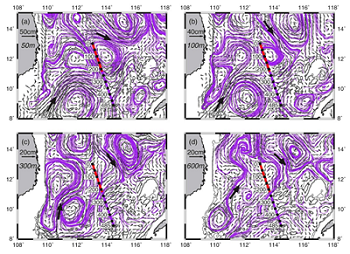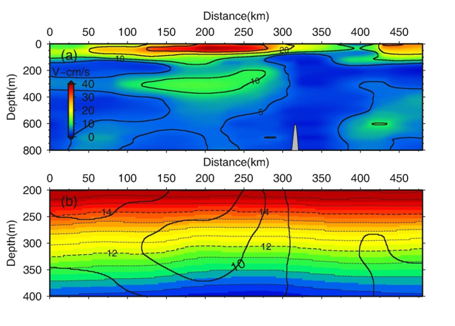地震海洋学方法揭示南海南部涡旋双极子产生潜流
利用反射地震研究水体结构是近年来的研究热点。近日获悉,唐群署等对南海南部一条地震测线进行水体结构成像研究,发现在南海海盆靠近南沙群岛一侧存在一透镜状异常,该异常位于表层水之下250m到600m之间,其中心深度为450m,截面宽度约为60km。结合HYCOM资料的分析,研究揭示该中尺度结构异常是由位于其北部的涡旋双极子产生的潜流所致。同时,该结果否定了其为涡旋结构的认识。
该成果基于传统的海洋多道地震探测地下结构的方法,获得空间连续的高分辨的水体反射地震图像,为物理海洋学家提供一个认识海洋的全新视角。该研究得到了国家973计划项目、国家自然科学基金项目等资助,相关成果发表在国际刊物Ocean Science,2013,9,P 631–638,http://www.ocean-sci.net/9/631/2013/os-9-631-2013.html
英文摘要如下:
A legacy seismic transect acquired on 30 and 31 May 2009 in the southern South China Sea (SCS) was reprocessed to reveal the thermohaline structure of the water column. In the study region, a mesoscale subsurface lens with extraordinary features was detected at 113.5°E, 11.5°N. It is centred at 450m depth, occupies both the subsurface and intermediate water from 250 to 600 m, and has an intersection diameter of around 60 km. The simulated results from Hybrid Coordinate Ocean Model reveal an eddy-induced subsurface current running southwestward along the deep basin edge and suggest that the imaged lens is a snapshot of the subsurface current core rather than a subsurface eddy.

1.HYCOM simulated velocities at different depths in the southern SCS on 30 May 2009. The purple lines are the streamlines derived from the velocities. Black arrows show the current directions at some key spots. The seismic transect with labeled distances is also superimposed.

2.Vertical sections of the HYCOM simulated current speeds (a) and temperature (b) along the seismic transect. Speeds contours in (a) are also superimposed in (b).
附件下载:
 粤公网安备44011502001245号
粤公网安备44011502001245号